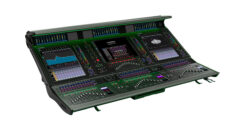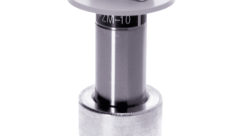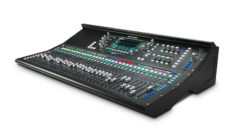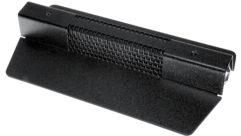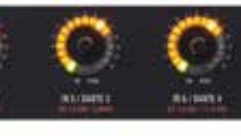
Technology Showcase: Automatic Microphone Mixers
May 1, 2007 12:00 PM,
By Bennett Liles
Solutions to simplify audioconferencing.

Biamp Systems AutoOne
Because necessity is the mother of invention, two problems have spawned the science of automatic microphone mixing. The more traditional situation has been one of having more than half a dozen participants using microphones in a freewheeling format where anyone can speak up at any time. The more participants, the greater the probability that even the most alert sound operator is going to be up-cutting syllables on every change in speaker.
The second, and more modern, scenario is one in which there is a permanent turnkey installation involving occasional use of multiple microphones, but the staffing budget does not provide for an operator.
The basic task of auto-mixing systems is to maintain open mics at the used inputs while attenuating or turning off the unused mixer channels and, when multiple channels are open, to maintain total system gain below the level generating acoustic ringing or feedback. There are various means used to accomplish these goals, including simple noise gates, adaptive threshold sensing, and gain reduction on the number of microphones (NOM) being used.

Audio-Technica AT-MX381 SmartMixer
CROWDED FIELD
The AS 8 TC from AKG Acoustics uses its patented Adaptive Proportional Gain algorithm to allocate individual gain in reference to a total level of all active channels while giving the channel with the most acoustic input the most gain and rejecting non-speech sounds from the process. Over time, the mixer adapts to the flow of speech and gives a progressive priority to the most consistently active channel, but it does not consider momentary bursts of ambient sound. A compressor/leveler keeps levels consistent.
The unit can handle mic- or line-level sources through a DIP switch setting and front-panel gain adjustment. An RS-232 control port makes the AS8 controllable with systems such as AMX and Crestron. Currently, the unit may be purchased for around $1,500.
Allen & Heath offers the iDR-8 auto mix processor with eight analog XLR mic/line inputs with 48V phantom power, eight analog line outs, two line ins and outs on 1/4in. connectors, 8-channel digital expansion port, MIDI in/out, DSP functions, and headphone monitor. With the iDR Manager software, users can design a customized system with programmable auto mixing, delays, four- and eight-band EQ, frequency-conscious dynamics, look-ahead limiter, ambient-noise compensator, and crossfader.
The unit is controllable with infrared and desk-mounted, Cat-5-connected controllers using the company’s RS-485-based PL-Anet bus. The iDR Series can also be controlled with a direct Ethernet PC connection. The MSRP is $3,899.
The AT-MX381 SmartMixer from Audio-Technica automatically switches eight inputs for a variety of applications. Each input is line/mic-capable with trim and level controls, has individually selectable 48V phantom power, and features a direct output for multitrack logging or recording for later editing. Up to 16 of these units may be linked with a supplied cable for up to 128 auto-mixed channels. The AT-MX381 offers three modes of priority selection in addition to a selectable last-mic-on feature that holds open the most recent microphone channel used.
The mixer can control other devices, and may be controlled by RS-232 from a PC running SmartMixer Software or by Crestron or AMX systems. The current price of the mixer is $1,985.
The Beyerdynamic Mix 10 NG 10-channel stereo mixing system has six electronically balanced mic inputs and four stereo line inputs, a mix input for external devices, and an insert point at the microphone master. You can route any input as a master or sub. External control is available via RS-232 port for systems such as Crestron or AMX, and there are LED indicators for cable protection, power, audio level, and level peak. The ducking function may be assigned to mic one for priority or configured for all mic channels. A vast range of system functions may be configured with the software application, including ducking, response threshold, and fade in/out.
The AutoOne from Biamp Systems uses adaptive threshold sensing, speech-frequency filtering, and NOM attenuation to minimize false gate triggering. The eight mic/line inputs can be doubled by stacking two units and setting them to master/slave status. Each input channel has trim, pad, level, active peak indicators, and 24V phantom power, and the aux output is switchable to receive either pre or post gate signals from the input channels. External equipment can be activated through logic outputs from the individual inputs on a nine-pin sub-D connector. Also featured is a last-mic hold function and selectable attenuation depth between -12dB and -40dB. With some shopping, the unit can be found for less than $1,000.

ClearOne Converge Pro
The Converge Pro from ClearOne features several selectable modes of operation among its eight mic/line inputs, including PA-adaptive, first-mic priority, and last mic. Other parameters are NOM, ambient level, gate threshold, off-attenuation adjust, hold time, and decay rate. Each input has gain adjust, phantom power, echo cancellation, noise cancellation, several types of filters, mute, chairman override, AGC and ALC on/off, auto/manual gate, adaptive ambient on/off, and pre-AEC channel. There are four line inputs on mini push-on terminal blocks and 12 balanced outputs. Mics may be separated into gating groups for more configuration options. The unit also includes an event scheduler and diagnostic console.
Clockaudio presents the MR88 digital automatic mixer with eight mic/line input channels incorporating automatic activity detection, multilevel priority settings, all mics active, one-at-a-time mode, and a last-mic-on function for maintaining constant ambient sound level.
The unit may be chained to others with an RJ-45 loop-through, and priority functions will extend across the whole stack. All features may be set up from a PC through the RS-232 port or with the LCD display on the front panel, which also has output level and channel-on LED indicators next to it. Another feature not commonly found on smaller mixers is the individual channel preamp direct-out for multitrack recording. Input channels include adjustable-off attenuation and two-band EQ.
For heavier applications, Crest Audio has introduced the HP-W series consoles with auto mix features on the first eight mono inputs. Available in 20, 28, or 36 total channel frames, the HP-W series features built-in adjustable threshold compressors on the auto mix channels. The input with the loudest acoustic signal will dominate while reducing the gain of the others, but the priority feature can override this.
The mixers also offer eight analog subgroups, 10 aux sends, and an 11×2 matrix, along with left, right, and mono outputs and 8-channel microprocessor-controlled mute groups and scenes. This versatile machine can go from small auto-mix events to a big show in the time it takes to push a few buttons.
An interesting product in this group comes from Dan Dugan Sound Design in the form of the Model E automatic mixing controller. Generally credited with being the inventor of automatic mixers, Dugan holds many patents in the field. Not technically a mixer itself, the Model E patches into eight insert points of another mixer, senses activity on the various channels, and performs smooth crossfades.
Realtime software control is made possible through a web browser applet that provides all the features and controls that would be found on an upscale hardware product. The units may also be optically linked to provide control for up to 64 channels. The MSRP is $2,995.
Innovative Electronic Designs markets its 4400/4800 Series automatic mixers with Proprietary Discriminator Circuit, Digital Attenuator Control, priority and filibuster functions, last mic on, and onput. The 4800 offers eight gated mic/line inputs with adjustable release time, two non-gated auxiliary line inputs, two line outputs, and two auxiliary line-level outputs. Direct outputs are also available, along with remote control interfaces on rear-panel, multi-pin connections. The front panel includes 48V phantom power switch (optional), auto/manual switch, and individual hardware pots for channel input level, and master A and B output levels. Other options include three-band EQ and aux input remote control.
The Amix-8 from Intelix offers three front-panel-selectable modes of automatic operation, including standard, last-mic-on, and first-come first-serve. Priority channel exercises control through a filibuster function. An option includes remote control by ReO and RS-232 on a multipin connector. The front panel includes manual level pots, activity and peak LED indicators, master level control, low cut buttons, a limiter selector, and an output-level LED meter. Mic/line-level selectors are included on the output and each input channel connector. The MSRP for the Amix-8 is $1,379.
The Voice-Matic mixer VM-4083 from IRP Professional Sound Products features the company’s patented Voice-Matic mixing control and Level-Matic II AGC on the main output. Phantom power is available on the eight electronically balanced mic/line inputs along with three-band TEQ, 20dB pad and high-pass filter.
The 4083 uses NOM attenuation control to attenuate the output level by 3dB for each doubling in the number of active channels. These features extend to all linked units. The mixer uses dynamic threshold sensing and has a preset 30dB attenuation depth. Flexibility is added with a channel status logic output and a buffered preamp output for each channel. Two electronically balanced auxiliary inputs and remote control are included along with two auxiliary outputs from each input channel.
Ivie Technologies offers the 1026 integrated automixer/digital processor. The 1026 has 10 mic/line software-switchable inputs; three modes, including auto mix, manual, or VOX operation; six outputs; a variety of remote-control options; internal 2×6 router; and DSP with EQ, two- or three-way crossovers, delay, compression, and limiting. The unit actually incorporates two auto mixers. Each input may be associated with either one, and both include the last-mic-on feature. NOM attenuation and attenuation depth are adjustable, and there is even a built-in pink-noise and sine-wave generator. The software presents a mixer display with all the features normally included on a hardware counterpart. The unit typically runs in the $2,000 range.
The DM84 digital matrix processor plus DSP from Lectrosonics has a uniquely powerful expansion capability using the company’s LecNet2 sound system architecture. The Digital Audio Network Interface (DANI) allows the units to be stacked for an unlimited number of inputs and 24 outputs at the master unit at the top of the stack. Signals are propagated back to the slave units, and the signals available at their outputs can be selected from the back-propagated audio rather than only from the eight inputs and four outputs on the individual unit. PC setup allows the range of front-panel knobs to be defined in software. Extensive DSP is available on each channel using a Sharc 300MHz DSP chip set. The DM84 can be found for less than $2,000.
The Automix Control 8 automatic mixer from Peavey Architectural Acoustics features 48V phantom power on its eight transformer-balanced mic/line inputs, along with switchable 100Hz low-cut filter, auto/manual selection with individual hardware gain controls, activity/clipping LED, channel insert points, 5V TTL status output, an assignable mutebus, and adjustable priority control on channels 1 and 2.
The output has gain trim, three sweepable notch filters, transformer-isolated main and aux outputs, a downward expander, and remote volume control. The units may be stacked for greater capacity, and each sports a handy see-through Plexiglass front-panel cover for easy visual monitoring with tamper-proof security. All inputs/outputs are on removable Euro connectors. Peavey has also incorporated its proprietary auto mix circuitry into products such as its Sanctuary Series mixers and the new Architectural Acoustics Prolinx DSP.
The Vortex EF2280 from Polycom can provide automatic mixing for up to eight microphones and four auxiliary line-level sources in a single venue. For greater capacity, up to eight EF2280 units may be linked on RJ-45 loop-through connections and remote controlled with Crestron, AMX, or other RS-232 links and infrared.
Setup with Conference Composer and InstantDesigner software enables all features and functions. NOM can be set across all linked units along with echo cancellation and user-adjustable AGC parameters.
Protech Audio markets the Model 2010 Dugan automixer to add automatic mixing capability to analog consoles. Similar to other Dugan controllers, the 5-channel Model 2010 connects to the mixer through TRS insert jacks and features easily switched manual and automatic modes. The units can also be linked and stacked to match the mixer’s channel capacity. The front panel includes an activity-indicator light and a large mute switch with indicator.
The Dugan Model 2010 can allow any courtroom, church, or other venue to expand its auto mixing capacity as it upgrades the audio system, without the need to buy a new mixer. The unit fits in 1/2RU to mount almost anywhere. The MSRP is $1,195.
The Rane RPM 88 programmable multiprocessor includes auto mixing among its many features, which is configurable through the Rane DragNet drag-and-drop configuration software. The unit includes eight balanced line/mic analog inputs and a 2-channel AES3 digital input and output. Remote control is available with optional Rane accessories through the RW 485 remote interface port and versatile input and output logic ports on Euroblock connectors. All parameters can be assigned to 24 internal, non-volatile presets and instantly recalled. Multiple units can be remote controlled over Ethernet links, and the front panel includes a three-segment LED meter; a control port; and power, Ethernet, and status indicators. The RPM 88 can found for around $2,500.
The Shure SCM-810 eight-input automatic microphone mixer can be linked to other Shure studio and field mixers. Gain is automatically adjusted for number of microphones, and the unit features a last-mic lock-on circuit to maintain ambient sound. The front panel includes activity and clipping indicators and a headphone output with level control. The inputs are mic level with low-frequency rolloff and high-frequency shelving EQ, and the output is mic/line switchable. Also featured is an aux level input with level control and peak output limiter with selectable thresholds. The units may be linked for auto control of up to 400 microphones. The MSRP is $1,750.
The Symetrix SymNet Audio Matrix 8×8 DSP is hardware-expandable and software-programmable to accommodate more than 300 DSP modules including both gating and adaptive level gain sharing automixers. Both types of automix modules feature a priority rank setting from 1 to 10 and offer direct outs that are post-channel auto gain, mute, and fader. These automix modules may be independent or chained together for up to 512 channels in linked hardware. Gating automix modules feature dead zones and last-on default channels and multiple channels may be programmed with these features. The unit has eight analog audio inputs with phantom power and eight outputs. It includes two RS-232 ports and one RS-485 port, eight analog control inputs, six open collector outputs, and three relay outputs.
The D-901 digital mixer from TOA Electronics is software-configurable to offer a range of auto-mixing functions for up to 12 mic/line inputs and eight line outputs. One of its more unique features is the ability to selectively split the NOM bus into four for room-combining operations.
The unit offers a range of gating parameters, compression, parametric EQ, and feedback suppression. While there is some front-panel menu navigation, it is divided into input and output sections, and it is very intuitive and remarkably simple. Four menu navigation buttons, level knobs, LED meters, and dedicated buttons allow control over more than 16 presets and a wide range of DSP and auto-mixing options.
Hardware configuration is done by adding various slide-in modules on the rear panel. One of these modules can allow remote serial control by AMX or Crestron systems or direct PC connection. The MSRP is $2,190 with configuration modules costing from $158 to $282 each.

Wideband Solutions Simphonix Si-400
In addition to its teleconferencing capabilities, the Simphonix Si-400 from Wideband Solutions can perform automatic mixing of up to four local microphones and output these to a sound-reinforcement system through its rear-panel, removable terminal blocks. Each input has software-selectable phantom power and auto mixing with Voice Activity Detection (VAD) for automated, adaptive ambient-sound level setting. AGC at each crosspoint in the mix matrix maintains consistent levels, and noise reduction extends to outside callers. The unit may be set up and remote controlled from anywhere through a web-based management interface. The rear panel includes headset telephone and network jacks, logic interface, two aux inputs, aux and amp outputs, conferencing in/out, and SP amp connection.
For More Information
AKG Acoustics
www.akgusa.com
Allen & Heath
www.allen-heath.com
Architectural Acoustics
aa.peavey.com
Audio-Technica
www.audio-technica.com
Beyerdynamic
www.beyerdynamic.com
Biamp Systems
www.biamp.com
ClearOne
www.clearone.com
Clockaudio
www.clockaudio.com
Crest Audio
www.crestaudio.com
Dan Dugan Sound Design
www.dandugan.com
Innovative Electronic Designs
www.iedaudio.com
Intelix
www.intelix.com
IRP Professional Sound Products
www.irp.net
Ivie Technologies
www.ivie.com
Lectrosonics
www.lectrosonics.com
Polycom
www.polycom.com
Protech Audio
www.protechaudio.com
Rane
www.rane.com
Shure
www.shure.com
Symetrix
www.symetrixaudio.com
TOA Electronics
www.toaelectronics.com
Wideband Solutions
www.widebandsolutions.com


